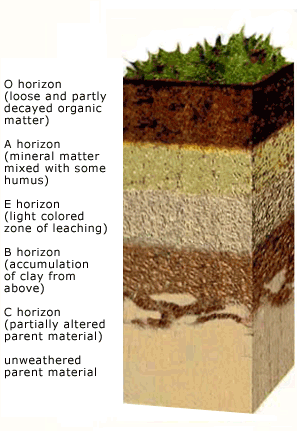Actual Temperature
9 degrees Celsius
Humidity : 70%
Rainfall : 15.4mm
Wind : Moderate Wind
9 degrees Celsius
Humidity : 70%
Rainfall : 15.4mm
Wind : Moderate Wind
Today I went to Botanical Garden on Plant Collection and due to bad weather we don't have practical class. Apparently I research on Soil Structure.
New Zealand pastoral farming is based on a grass and clover system. This is cheaper than the more
intensive feeding systems used overseas and allows us to be competitive in an international market. However to maintain productivity we need to preserve our soils and their structure. It is the
biological and organic system below ground that
supports the grasses and clover. It is the engine
room of a farming system.
The diagram opposite depicts a healthy soil profile.
Note the root mass and root depth. Other factors to
consider in a healthy soil are soil structure, porosity
(soil pores), colour, number of earthworms and soil
smell.
Soil is prone to damage. A decline in soil quality
has a marked impact on pasture production,
pasture quality, animal health and the environment.
Damaged paddocks take time to become healthy
again, so avoiding pasture damage is the best
strategy.
General information
Soil structure controls the movement of air and
water through the soil and the ability of roots to
penetrate into the soil. It also provides a habitat for
a number of beneficial organisms like earthworms,
bacteria and fungi. Soil with good structure has a
significant number of large pores that provide air
to these organisms, good drainage and high water-
holding capacity. If your soil is physically healthy and
fertile, your pasture production will be high.
A high soil organic matter content increases
aeration, water holding capacity and nutrient
holding capacity. High organic matter in soils is
associated with a healthy soil. Organic matter
losses can be caused by repeated cultivation and
compaction.
A soil profile showing a well aerated soil structure
with few clods.
Pugging and compaction can degrade the soil
structure. Pugging is caused by animal treading
in wet conditions. Compaction is caused by
animal treading, vehicle movement and repeated
cultivation.
Pugging and compaction reduce the number of
pores in the soil. This leads to reduced pasture
growth, more frequent and persistent surface
ponding and increased sediment, nutrient and
effluent losses through surface run-off. Weed
invasion can occur in the bare sites created by
pugging and compaction. Subsequent grass growth
on pugged paddocks is significantly reduced.
Recommended actions and best
management practices
To minimise damage like this:
-
stand heavy animals off pasture in very wet
weather
-
graze paddocks prone to pugging before the very
wet weather arrives
-
constantly monitor pugging and compaction
during at-risk periods and move stock before
damage occurs
-
use the bike rather than the tractor where possible
-
avoid working the soil when it is wet
-
drop fences when moving stock in very wet
weather
-
back-fence cows to limit pasture damage in the
winter
-
if practical, choose block grazing over strip grazing
in the winter
-
limit cultivation and use low impact cropping
techniques such as strip tillage or direct drilling
-
if re-contouring, ensure erosion control measures
are in place and use a skilled contractor.
- ensure the pH is in the recommended range to create the best soil environment for earthworms

No comments:
Post a Comment